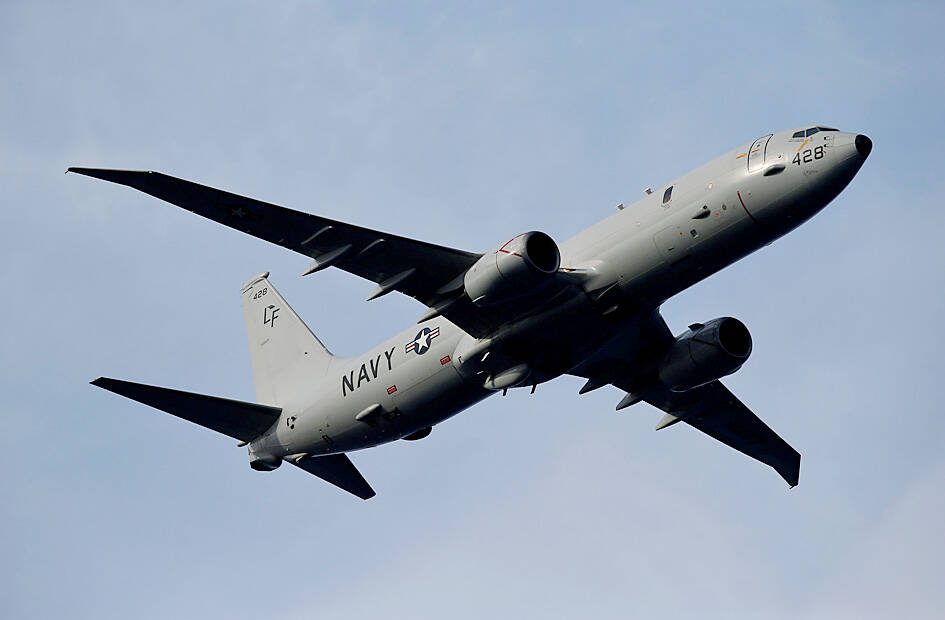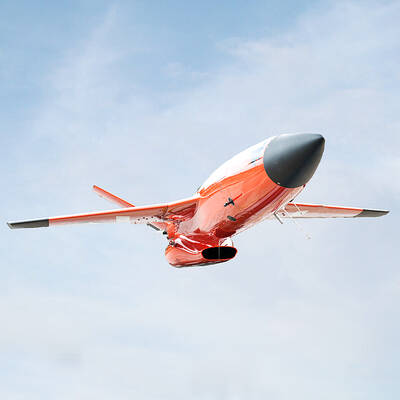A US naval aircraft yesterday made a rare transit through the Taiwan Strait, a flight the US Navy said showed Washington’s “commitment to a free and open Indo-Pacific” region.
The US Navy P-8A Poseidon transited the Taiwan Strait in international airspace, according to a statement released by the 7th Fleet of the US Pacific Command.
“By operating within the Taiwan Strait in accordance with international law, the United States upholds the navigational rights and freedoms of all nations,” the statement said. “The aircraft’s transit of the Taiwan Strait demonstrates the United States’ commitment to a free and open Indo-Pacific.”

Photo: Reuters
In Taipei, the Ministry of National Defense also confirmed the aircraft’s passage, saying in a statement that the military was on top of the situation as a US military aircraft flew northward in the Taiwan Strait yesterday and that it did not see anything out of the ordinary.
US warships have been making routine, almost monthly, passages through the waterway separating Taiwan and China over the past three years as tensions across the Taiwan Strait have escalated, but it is rare for a US warplane to do so.
The last time a US warplane, also a US Navy P-8A Poseidon, flew over the waterway was on June 24 last year, a day after China sent 29 planes into Taiwan’s air defense identification zone — at that point the third-highest daily number since the start of last year.

Photo: screen grab from CBS News
The Boeing P-8 Poseidon is a US maritime patrol and reconnaissance aircraft developed and derived from the civilian Boeing 737-800.
The P-8 Poseidon operates in anti-submarine warfare, anti-surface warfare and intelligence, surveillance and reconnaissance roles.
China yesterday accused the US of “endangering” peace and stability in the Taiwan Strait.
The Eastern Theater Command of the People’s Liberation Army (PLA) said its forces closely monitored the aircraft.
“The US side’s actions deliberately interfered with and disrupted the regional situation and endangered peace and stability in the Taiwan Strait. We firmly oppose this,” it said in a statement.
Meanwhile, CIA Director William Burns said that US intelligence shows that Chinese President Xi Jinping (習近平) has instructed his nation’s military to “be ready by 2027” to invade Taiwan, though he might be harboring doubts about his ability to do so given Russia’s experience in its invasion of Ukraine.
Burns, in a television interview that aired on Sunday, said that the US must take “very seriously” Xi’s desire to ultimately control Taiwan, even if military conflict is not inevitable.
“We do know, as has been made public, that President Xi has instructed the PLA, the Chinese military leadership, to be ready by 2027 to invade Taiwan, but that doesn’t mean that he’s decided to invade in 2027 or any other year as well,” Burns told CBS’ Face the Nation.
“I think our judgement at least is that President Xi and his military leadership have doubts today about whether they could accomplish that invasion,” he said.
Burns said the support from the US and European allies for Ukraine following Russian President Vladimir Putin’s invasion of that nation could be acting as a potential deterrent to Chinese officials, but said the risks of a possible attack on Taiwan would only grow.
“I think, as they’ve looked at Putin’s experience in Ukraine, that’s probably reinforced some of those doubts,” Burns said. “So, all I would say is that I think the risks of, you know, a potential use of force probably grow the further into this decade you get and beyond it, into the following decade as well. So that’s something, obviously, that we watch very, very carefully.”
Additional reporting by Reuters

‘WIN-WIN’: The Philippines, and central and eastern European countries are important potential drone cooperation partners, Minister of Foreign Affairs Lin Chia-lung said Minister of Foreign Affairs Lin Chia-lung (林佳龍) in an interview published yesterday confirmed that there are joint ventures between Taiwan and Poland in the drone industry. Lin made the remark in an exclusive interview with the Chinese-language Liberty Times (the Taipei Times’ sister paper). The government-backed Taiwan Excellence Drone International Business Opportunities Alliance and the Polish Chamber of Unmanned Systems on Wednesday last week signed a memorandum of understanding in Poland to develop a “non-China” supply chain for drones and work together on key technologies. Asked if Taiwan prioritized Poland among central and eastern European countries in drone collaboration, Lin

The Chien Feng IV (勁蜂, Mighty Hornet) loitering munition is on track to enter flight tests next month in connection with potential adoption by Taiwanese and US armed forces, a government source said yesterday. The kamikaze drone, which boasts a range of 1,000km, debuted at the Taipei Aerospace and Defense Technology Exhibition in September, the official said on condition of anonymity. The Chungshan Institute of Science and Technology and US-based Kratos Defense jointly developed the platform by leveraging the engine and airframe of the latter’s MQM-178 Firejet target drone, they said. The uncrewed aerial vehicle is designed to utilize an artificial intelligence computer

The US government has signed defense cooperation agreements with Japan and the Philippines to boost the deterrence capabilities of countries in the first island chain, a report by the National Security Bureau (NSB) showed. The main countries on the first island chain include the two nations and Taiwan. The bureau is to present the report at a meeting of the legislature’s Foreign Affairs and National Defense Committee tomorrow. The US military has deployed Typhon missile systems to Japan’s Yamaguchi Prefecture and Zambales province in the Philippines during their joint military exercises. It has also installed NMESIS anti-ship systems in Japan’s Okinawa

Renewed border fighting between Thailand and Cambodia showed no signs of abating yesterday, leaving hundreds of thousands of displaced people in both countries living in strained conditions as more flooded into temporary shelters. Reporters on the Thai side of the border heard sounds of outgoing, indirect fire yesterday. About 400,000 people have been evacuated from affected areas in Thailand and about 700 schools closed while fighting was ongoing in four border provinces, said Thai Rear Admiral Surasant Kongsiri, a spokesman for the military. Cambodia evacuated more than 127,000 villagers and closed hundreds of schools, the Thai Ministry of Defense said. Thailand’s military announced that